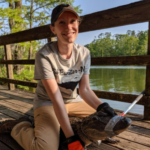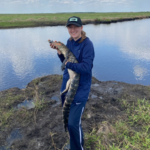
Scott Belcher (Project 3) and trainees Kylie Rock and Hannah Starnes‘ study on PFAS Found in Blood of Dogs, Horses Living Near Fayetteville, N.C. was selected as the NIEHS Extramural Paper of the Month! The Extramural Papers of the Month are selected based on their important findings and potential for public health impact.
Dogs and horses may be important indicators of exposure to PFAS Companion animals and livestock could provide insight into human exposure to PFAS inside and outside the home, according to an NIEHS-funded study. The scientists identified elevated levels of PFAS in dogs and horses from Gray’s Creek, North Carolina — a neighborhood near a PFAS manufacturing plant.

The team recruited participants with well water PFAS contamination, following concerns raised by community members about the health of their pets. Then, they took blood samples from the participants’ animals — 31 dogs and 32 horses— to test for 33 types of PFAS.
Every single animal had at least one PFAS detected, with over half of dogs and horses having a minimum of 12 PFAS in their blood. However, the types of PFAS and concentrations of the chemicals differed between animals. For example, dogs that drank bottled water provided by their owners had higher levels of PFAS from indoor sources, such as paint and consumer products. Horses that lived outdoors and dogs that drank well water had higher levels of the PFAS compounds produced at the nearby plant.

Within dogs, analysis revealed that concentrations of two types of PFAS were similar to the concentrations found in children from another North Carolina town, downstream of the PFAS manufacturing plant. The researchers also found changes in key proteins related to kidney and
liver function in the animals’ blood, which are known to be primary targets of PFAS toxicity in humans.
According to the authors, these findings suggest that dogs and horses may provide critical information about routes of exposure and potential PFAS toxicity, particularly during sensitive developmental windows such as during childhood.
